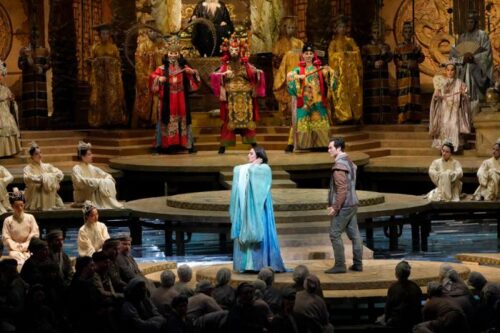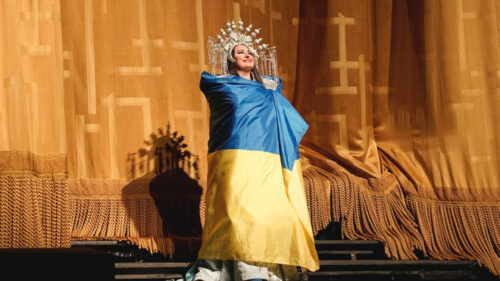 United States The Met: Live in HD – Puccini, Turandot: Soloists, Chorus and Orchestra of the Metropolitan Opera / Marco Armiliato (conductor). Transmitted live from the Metropolitan Opera, New York, to Cineworld Basildon, Essex, 7.5.2022. (JPr)
United States The Met: Live in HD – Puccini, Turandot: Soloists, Chorus and Orchestra of the Metropolitan Opera / Marco Armiliato (conductor). Transmitted live from the Metropolitan Opera, New York, to Cineworld Basildon, Essex, 7.5.2022. (JPr)

Production:
Production and Set designer – Franco Zeffirelli
Costume designers – Anna Anni, Dada Saligeri
Lighting designer – Gil Wechsler
Choreography – Chiang Ching
Stage director – J. Knighten Smit
Cast included:
Turandot – Liudmyla Monastyrska
Calàf – Yonghoon Lee
Liù – Ermonela Jaho
Timur – Ferruccio Furlanetto
Ping – Alexey Lavrov
Pang – Tony Stevenson
Pong – Eric Ferring
Emperor Altoum – Carlo Bosi
Mandarin – Jeongcheol Cha
Live in HD Director – Gary Halvorson
Live in HD Host – Nadine Sierra
Returning to the Met’s Turandot my mind wandered back nearly thirteen years to when I first saw and heard it and we were shown designer Franco Zeffirelli (who sadly died three years ago) talking about it in 1987 when this version premiered. He said how, ‘A spectacle is a good investment, now the Met will have a good Turandot for the next 25 years.’ It was based on one he had staged at La Scala in Milan which Ferruccio Furlanetto – in his backstage interview with the personable Nadine Sierra – mentioned he had appeared in previously as Timur. Zeffirelli had continued, ‘I have taken away a lot of the junk from that one – unnecessary tricks or slips of taste. The spectacle remains, but it is now more refined. It seems my destiny to come to New York with my ideas clear, in full maturity, with the problems worked out.’
Zeffirelli explained his production’s full-on Chinese setting as being in ‘the time of fairy tales’ and admitted to not letting historical authenticity cloud his imagination. He also said, ‘I have had some help with style and gestures, and the use of masks for Ping, Pang and Pong comes from the Peking Opera, but this production represents no particular dynasty. The idea for it comes from my own fantasy. Puccini is grand spectacle; it is larger than life … and the Metropolitan Opera offers technical possibilities that no other house in the world does.’ Zeffirelli revealed how his Turandot owes much of its grandeur not only to New York’s stage machinery (which John Sellars – in charge of production at the Met – described in some detail before Act II) but to a special use of plastics for set-building developed in Zeffirelli’s home country of Italy, ‘Four years ago we began experimenting with plastic techniques, we colour it with glass paint, glue, gold foil, mother-of-pearl.’
Obviously Zeffirelli’s Turandot is now ten years past that quarter of a century milestone and in the unforgiving close-up gaze of Gary Halvorson’s cameras his sets do look a little worse for wear and dusty at times (and so do some of the costumes). I wonder how much of the original concept has been diluted by frequent revivals (the latest here is by J. Knighten Smit)? Regardless, much Zeffirelli clearly remains and proves ideal again for filming because we in the cinema audience can be taken in amongst everybody onstage and the ‘grand spectacle’ they are part of. Zeffirelli’s chinoiserie – assisted by those costumes from Anna Anni and Dada Saligeri and lighting from Gil Wechsler – brings us loads of bamboo, sweeping pagodas, a throne room of gold and silver, acrobats, colourful dances (choreographed by Chiang Ching), moonlit nights, realistic looking severed heads on pikes, Chinese dogs and lions, as well as a magnificent dragon: all showcasing a cast of thousands … well hundreds!
Is there any room left on the stage for Puccini’s drama – such as it is – to unfold? My reaction, as before, is not really and the principal singers tend to get lost in the ensuing melee; at least, until the stage clears in the third act after Liù’s death leaving Calàf and Turandot alone. Up to that point it was difficult to see what he saw in her – beyond obtaining the unobtainable – as Liudmyla Monastyrska’s cruel ice princess was proving especially glacial regardless of how ardently Yonghoon Lee’s prince was pursuing her. It was only after he plucked up the courage to kiss Turandot that she melted (!) and as a real woman emerged – with the moment reflected on Monastyrska’s face – we finally got to see a genuine connection between the two of them.
Strangely here, it is the Franco Alfano completion that allows the singers to display these inner emotions since there are no other distractions onstage and we can focus entirely on Turandot and Calàf. It is clearer than ever that Puccini’s difficulty in completing this work was because he was unable to create the sense of abandonment to desire this final duet deserved here. On the incomplete sketch the composer left behind was written ‘E poi Tristano’ (‘And then Tristan’), however Puccini was not Wagner!

Monastyrska was a reluctant replacement for Anna Netrebko, dropped by the Met because of her perceived connections to Vladmiir Putin, and it was the Met’s general manager, Peter Gelb, who persuaded Monastyrska that she could bring attention to the plight of her compatriot Ukrainians. It was a role she had set aside after some Kyiv – of all places! – performances in 2015. In a filmed interview she spoke movingly of her mission to sing, her homeland, upbringing there and extended family. Monastyrska would go on to drape herself in the Ukrainian flag at her curtain call at the end of the opera. We heard from Gelb how she will join the Ukrainian Freedom Orchestra (created by the Metropolitan Opera and the Polish National Opera) for a European and American tour (28 July – 20 August) including stops in the U.K (the BBC Proms and Snape Maltings), France, Germany, and the Netherlands, before culminating with concerts in New York and Washington, DC.
The orchestra will include recent refugees, Ukrainian members of European orchestras, and some of the top musicians of Kyiv, Lviv, Kharkiv, Odesa, and elsewhere in Ukraine. The Ministry of Culture and Information Policy of Ukraine is supporting the project by enabling male musicians to forego defending their country other than by taking up their instruments to help demonstrate the power of art in combating the actions of an aggressor. Money raised from the tour will go to support Ukrainian artists. It will be led by Canadian-Ukrainian conductor – and Gelb’s wife – Keri-Lynn Wilson. Monastyrska will sing Leonore’s ‘Abscheulicher!’ from Beethoven’s Fidelio, and also performed will be Ukrainian composer Valentin Silvestrov’s Seventh Symphony, Chopin’s Second Piano Concerto (played by Anna Fedorova, also from Ukraine) and either the Brahms Fourth or Dvořák Ninth symphonies.
‘In questa reggia’ began a little reflectively as if Monastyrska was indeed thinking of her family as we heard her say she was. Whilst we didn’t get the torrent of sound some Turandots bring to this demanding aria, her tone was mostly steady throughout, if a touch steely, yet that was balanced by much Italianate warmth and careful phrasing. What was not in doubt was Monastyrska’s fearless top notes and her willingness to duel in high Cs with Calàf at the conclusion of ‘In questa reggia’.
South Korean tenor Yonghoon Lee impressed me because he left nothing in the dressing room and gave Calàf his all. Lee clearly was concerned to sing the best – and frequently the loudest – he could in what is dramatically a thankless part. Calàf is callous towards Liù who loves him, appears oblivious – at least in the Alfano completion – to her sacrifice and as a result, totally single-minded in the pursuit of Turandot that Lee portrayed pretty well. There were a very few occasions where he seemed to put his voice under too much pressure, but generally all the notes sounded as they should. ‘Nessun Dorma’ did not disappoint – if we consider he was singing it live – and his ‘Vincerò’ top B resounded and Lee deserved the ovation he got. Even better was when the tenor didn’t strive to sing fortissimo and coloured his voice to express more of the beautiful poetry in Puccini’s Italianate lines.
The most nuanced acting and singing came from Ermonela Jaho as Liù who sensitively phrased her arias, ‘Signore, ascolta!’ and ‘Tu che di gel sei cinta’. Jaho made a splendidly devoted slave girl and the subtlety of her performance was a little at odds with much that was going on around her. Jaho is a heart on her sleeve singer and the emotion of what she sang affected her visibly but not vocally because there was the most exquisite control possible of gossamer-like pianissimi.
Ferruccio Furlanetto, brought considerable gravitas to the aged, blind Timur and even if his voice may not now have the security of its former years, his cry of anguish at Liù’s death had potency and poignancy. Zeffirelli never considered the interventions of the Imperial minsters as merely timewasting distractions and so gave each their individual character. All three were better than many, with Alexey Lavrov (Ping), Tony Stevenson (Pang) and – the notably sweet-voiced – Eric Ferring (Pong) clearly relishing their vignettes. Carlo Bosi’s pronouncements as the supposedly enfeebled Emperor Altoum were much stronger than usual. Watch out for bass-baritone Jeongcheol Cha in the future as he was very impressive as the Mandarin.
The orchestral landscape of Puccini’s vivid score is so visual and with the excellent Met Orchestra reverberating from the auditorium’s loudspeakers this was as an exciting and gripping Turandot as I can remember. I believe the wonderful Marco Armiliato conducted this with momentum and his usual Puccinian flair. He rarely held the music back – ok maybe he did a little when Turandot sang – and unleashed some brilliant climaxes.
As I have written before, had I been in the opera house it may have been possible to fault the ensemble between conductor, soloists and the enormous, well-drilled and stentorian chorus but judging this isn’t possible in a live broadcast. When it all came together in the final tableau with the golden glitter raining down, this is a traditional Turandot production improbable anywhere in 2022 apart from at the Met … yet who knows for how much longer that will be possible?
Jim Pritchard
For more about what is coming up in The Met: Live in HD series click here.
